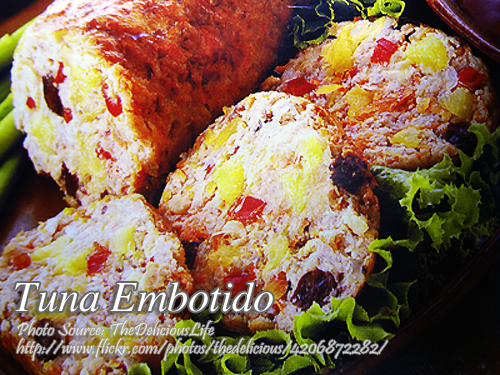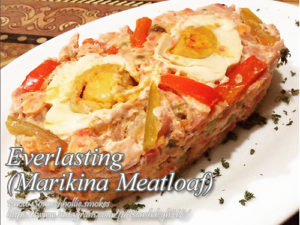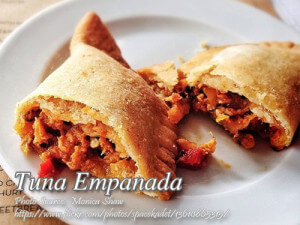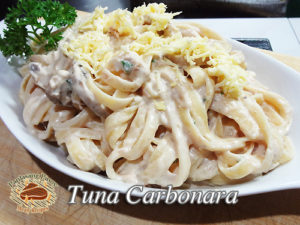All I can say is that this tuna embotido is the healthiest kind of embotido. Because tuna is rich in omega 3 fatty acid that is good for the heart. Cooking is also really simple and very similar to the pork embotido. The only pork that is added in this recipe is the pork bouillon.
A Healthier Twist on a Classic Filipino Favorite
When it comes to comfort food, embotido always makes it to the list of every Filipino household. Traditionally made with pork, this classic Filipino meatloaf is often served during fiestas, family gatherings, and special occasions. But did you know there’s a healthier version that’s just as delicious? That’s right! It’s packed with the same savory goodness while being heart-friendly, thanks to the omega-3-rich tuna.
The idea of making tuna embotido came to me from my uncle, Mang Tony. He’s the family’s go-to guy for all things embotido. One weekend, while visiting him in Quezon, he told me, “Why not try using tuna instead of pork? It’s healthier, and just as tasty!” That was it—I knew I had to give it a shot.
A Family Recipe with a Twist
Mang Tony always emphasized the importance of using fresh ingredients. For this tuna embotido, I made sure to use good-quality canned tuna. The trick, according to him, is to marinate the tuna first. Pineapple syrup, a bit of salt, and pepper do wonders for flavoring the fish. It may seem unusual, but the pineapple syrup tenderizes the fish while adding a subtle sweetness. After marinating for about 10 minutes, it’s best to drain the fish thoroughly to avoid a soggy texture.
Once the fish is drained and chopped, it’s time to mix it with the other ingredients. I remember my cousin, Ate Lorna, telling me to always mix well. She’s right—it’s important to make sure the flavors meld together. Adding a bit of pork bouillon makes a huge difference, giving the tuna embotido a depth of flavor similar to the classic pork version.
Wrapping and Steaming the Tuna Embotido
Rolling the mixture into foil is one of those things that takes a bit of practice. I used to struggle with shaping it, but Mang Tony showed me a trick: use just the right amount of filling and gently press as you roll. This helps achieve that cylindrical shape without breaking apart. The foil also locks in moisture, keeping the embotido juicy and tender.
The steaming process is pretty straightforward—around 30 minutes should do it. Steaming is preferred because it cooks the embotido evenly without drying it out. Once it cools down, I sometimes like to give it a quick fry for a golden, crispy exterior. That little bit of crunch on the outside adds a satisfying contrast to the soft, flavorful interior.
A Slice of Nostalgia
Every time I make this embotido, I’m reminded of those weekends at Mang Tony’s place. The kitchen filled with the aroma of freshly cooked embotido, the sound of sizzling as it browns, and the simple joy of sharing a meal with family. Nowadays, I make it whenever I’m feeling nostalgic or craving something hearty yet healthy.
Serve the tuna embotido sliced with a generous side of banana ketchup. Trust me, the slight sweetness of the ketchup perfectly balances the savory, slightly tangy flavors of the embotido. It’s one of those dishes that remind you of home, wherever you are.
A Quick Food for Thought
Did you know that embotido originally came from Spanish influence? Back then, embutido referred to cured sausages. In the Philippines, we transformed it into a hearty meatloaf, using available ingredients and adding our own local flair. This tuna version is just another evolution, proving that Filipino cuisine constantly adapts while keeping its core essence intact.
Why Tuna Embotido Works
Tuna embotido is not just healthier; it’s also incredibly versatile. The use of pineapple syrup in marination helps enhance the tuna’s flavor while softening the texture. Adding a bit of pork bouillon balances the fishy taste and gives that familiar embotido richness. Steaming, instead of baking, preserves the moisture, making each bite succulent.
For beginners, this recipe is a great way to experiment with flavors while keeping it simple. Whether served as a main dish or a merienda snack, it is sure to be a hit.
Next time you’re craving something hearty yet guilt-free, give it a try. You’ll love how easy it is to make and how much comfort it brings, especially when paired with good company and happy memories.
How to Cook Tuna Embotido
Ingredients
- 350 grams tuna fillet cut into chunks
- 1 pc large onion chopped
- 1/4 cup raisins
- 1 pc pork bouillon cube
- 1 can 243 grams crushed pineapple (reserve syrup)
- 1 pc medium size red bell pepper diced
- 1 pc medium carrot coarsely grated
- 1 pc egg
- 1 stalk celery chopped
- 1/4 cup flour
Instructions
How to cook Tuna Embotido:
- Marinate fish in pineapple syrup, 1/2 tsp iodized salt and 1/4 tsp pepper for 10 minutes. Drain and discard marinade.
- Chop fish then combine with remaining ingredients. Season with 3/4 tsp iodized salt and 1/4 tsp pepper. Mix well. Divide into 3 portions.
- Wrap in foil then roll and shape into cylindrical shape, just like the ordinary embotido.
- Steam for 30 minutes. Cool. If desired, fry in oil and brown all sides.
- Slice and serve with banana ketchup.
Notes
Cooking Tips:
Marinate for Maximum Flavor
Marinating the tuna in pineapple syrup, salt, and pepper for at least 10 minutes not only infuses it with a subtle sweetness but also helps tenderize the fish. Make sure to drain the marinade properly afterward to avoid excess moisture in your embotido. This step ensures that your embotido has a balanced, savory-sweet taste and a firm texture.Shape and Wrap Properly
To achieve the signature cylindrical shape of embotido, carefully wrap the tuna mixture in foil and press gently as you roll. This helps maintain the form during steaming, preventing it from breaking apart. Secure the edges tightly to lock in moisture, keeping the embotido juicy and flavorful.Fry for Extra Texture
While steaming cooks the embotido thoroughly, frying it afterward adds a golden, crispy exterior that enhances both flavor and texture. Use just a little oil to brown all sides evenly, making sure not to overcook. This final step gives the fish embotido a satisfying crunch while keeping the inside moist and tender.






Sounds good! I might try this soon. Thanks for sharing. 🙂
Hi Patricia, good luck on your cooking!